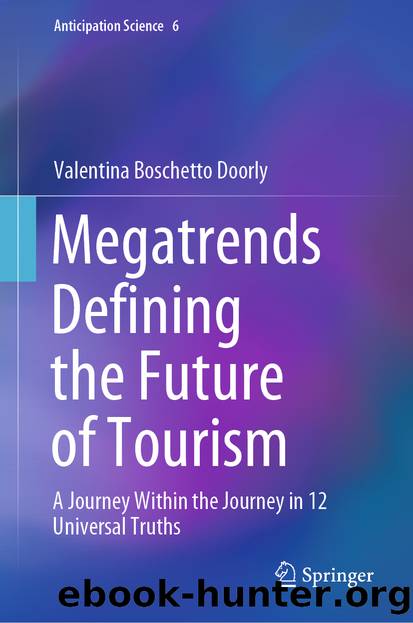Megatrends Defining the Future of Tourism by Valentina Boschetto Doorly

Author:Valentina Boschetto Doorly
Language: eng
Format: epub
ISBN: 9783030486266
Publisher: Springer International Publishing
6.2.2 Extreme Weather Events and Solidarity Tourism
Whereas continental cities are set to experience the highest increase in temperatures, islands and costal areas’ temperatures will do so to a lesser extent: half or even 1/3 when compared to the inland areas.
However, coastal areas will be at risk of severe erosion to the point of disappearing, submerged by rising sea levels. Europe’s coastline stretches for over 100.000 km with many areas highly populated and developed.
The UK is according to studies, set to be by far the worst affected, with projections indicating it will take the brunt of 22–28% of all flood related damages in Europe by 2100 followed by France, Italy and Norway.
Coastline will be rendered incrementally vulnerable by a combination of rising sea levels due to ice melting in the Polar Cap, tidal surge and storms occurrence, which, is also increasing in frequency and intensity. The overall economic damage caused by coastal flooding is projected to grow from the current €1.25 billion a year to €961 billion a year by 2100. This represents a 75-fold increase (Carbon Brief organization 2019).
Extreme weather events will impact coastal areas as well as inland regions harming the local tourist economy and possibly causing permanent loss of natural and man made assets.
What will happen when high profile amenities, UNESCO World Heritage sites are ravaged by the fury of the elements? Well, such events are already happening and we will use the example of an unprecedented tempest that hit both a coastal area as well as a mountainous one in two highly geared tourism economies, and both UNESCO World Heritage Sites.
The world-renowned area of Portofino, on the Ligurian coast in North of Italy, has recently made its acquaintance with the devastation of climate change, and so too the Dolomites, located north of Venice. Both are in the A-list census of UNESCO World heritage sites.
Encased in a precious nest of Mediterranean scrub, extensively protected by land and by sea through a marine natural reserve, Portofino and the nearby coastal area of Liguria attract 15 million bed nights a year. The miniature jewel of Portofino and its 400 residents competes for visibility with the nearby Cinque Terre jotting out in the turquoise sea. The colourful joy of this landscape was brutalised by an extreme weather event in 2018.
In between Saturday the 27th and Tuesday the 30th of October 2018, the north of Italy was hit by one of the most extreme and violent storms ever recorded over the peninsula. The depression, named Vaia, triggered furious Sirocco wind turbulence, raising seas with waves exceeding 10 m, and then sweeping over land with gusts at over 200 km/h. Pushing inland, it delivered its maximum impact on the eastern section of the Dolomites after having ravaged the Liguria coast.
Within three days, the north of Italy was shaken by a fury that left everyone shocked, with media gasping for words. Vaia was a “depression of extremely rare depth” with an “explosive cyclogenesis” 978 hPa at sea level “one of the lowest and deepest depression values ever recorded in two centuries” (Nimbus 2018).
Download
This site does not store any files on its server. We only index and link to content provided by other sites. Please contact the content providers to delete copyright contents if any and email us, we'll remove relevant links or contents immediately.
Life 3.0: Being Human in the Age of Artificial Intelligence by Tegmark Max(5402)
The Sports Rules Book by Human Kinetics(4210)
The Age of Surveillance Capitalism by Shoshana Zuboff(4115)
ACT Math For Dummies by Zegarelli Mark(3931)
Unlabel: Selling You Without Selling Out by Marc Ecko(3552)
Blood, Sweat, and Pixels by Jason Schreier(3530)
Hidden Persuasion: 33 psychological influence techniques in advertising by Marc Andrews & Matthijs van Leeuwen & Rick van Baaren(3413)
The Pixar Touch by David A. Price(3329)
Urban Outlaw by Magnus Walker(3300)
Bad Pharma by Ben Goldacre(3206)
Project Animal Farm: An Accidental Journey into the Secret World of Farming and the Truth About Our Food by Sonia Faruqi(3138)
Kitchen confidential by Anthony Bourdain(2966)
Brotopia by Emily Chang(2947)
Slugfest by Reed Tucker(2897)
The Content Trap by Bharat Anand(2835)
The Airbnb Story by Leigh Gallagher(2749)
Coffee for One by KJ Fallon(2516)
Smuggler's Cove: Exotic Cocktails, Rum, and the Cult of Tiki by Martin Cate & Rebecca Cate(2423)
Beer is proof God loves us by Charles W. Bamforth(2340)
